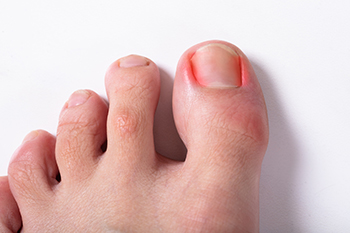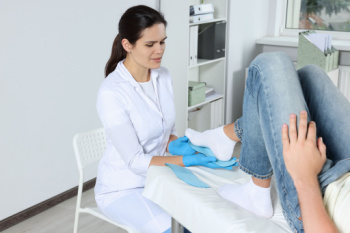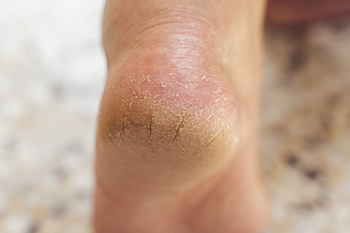Items filtered by date: July 2024
Painful Ingrown Toenails

Ingrown toenails occur when the edge of a toenail grows into the surrounding skin, instead of growing over it, causing pain, tenderness, redness, and swelling. This often occurs on the big toe. Preventing ingrown toenails involves cutting nails straight across and avoiding trimming them too short. Wearing proper-fitting shoes and socks can also reduce pressure on toes. Ingrown toenails can be very painful. If you suffer from persistent or infected ingrown toenails, it's suggested that you seek professional care from a podiatrist. They can safely trim or remove the ingrown portion of the nail, prescribe antibiotics if needed, and offer advice on preventing future occurrences. Prompt treatment from a podiatrist can prevent complications, such as infection or the need for more extensive procedures.
Ingrown toenails can become painful if they are not treated properly. For more information about ingrown toenails, contact one of our podiatrists of Podiatry Services . Our doctors can provide the care you need to keep you pain-free and on your feet.
Ingrown Toenails
Ingrown toenails occur when a toenail grows sideways into the bed of the nail, causing pain, swelling, and possibly infection.
Causes
- Bacterial infections
- Improper nail cutting such as cutting it too short or not straight across
- Trauma to the toe, such as stubbing, which causes the nail to grow back irregularly
- Ill-fitting shoes that bunch the toes too close together
- Genetic predisposition
Prevention
Because ingrown toenails are not something found outside of shoe-wearing cultures, going barefoot as often as possible will decrease the likeliness of developing ingrown toenails. Wearing proper fitting shoes and using proper cutting techniques will also help decrease your risk of developing ingrown toenails.
Treatment
Ingrown toenails are a very treatable foot condition. In minor cases, soaking the affected area in salt or antibacterial soaps will not only help with the ingrown nail itself, but also help prevent any infections from occurring. In more severe cases, surgery is an option. In either case, speaking to your podiatrist about this condition will help you get a better understanding of specific treatment options that are right for you.
If you have any questions please feel free to contact our office located in Murrieta, CA . We offer the newest diagnostic and treatment technologies for all your foot and ankle needs.
Why Properly Fitted Shoes Are Important
 Wearing the right shoes is essential for maintaining foot health and preventing various foot problems. Ill-fitting shoes can lead to or worsen conditions such as bunions, calluses, corns, and deformities like hammer, claw, or mallet toes. These issues not only cause discomfort but can become more problematic if not addressed. Properly fitted footwear plays a significant role in relieving pain caused by foot deformities and joint problems. It also helps prevent these issues from progressing and can aid in the recovery process post-surgery. When selecting new shoes, try them on later in the day when your feet are the largest. It is important to measure both feet and choose the larger size if they differ. Shoes should have a wide, deep-toe box, a low heel, and a supportive sole. They should also allow your toes to move freely and fit snugly in the widest part of the shoe. If you have problems that may be the result of wearing ill-fitting shoes, it is suggested that you schedule an appointment with a podiatrist for an exam, diagnosis, and treatment options.
Wearing the right shoes is essential for maintaining foot health and preventing various foot problems. Ill-fitting shoes can lead to or worsen conditions such as bunions, calluses, corns, and deformities like hammer, claw, or mallet toes. These issues not only cause discomfort but can become more problematic if not addressed. Properly fitted footwear plays a significant role in relieving pain caused by foot deformities and joint problems. It also helps prevent these issues from progressing and can aid in the recovery process post-surgery. When selecting new shoes, try them on later in the day when your feet are the largest. It is important to measure both feet and choose the larger size if they differ. Shoes should have a wide, deep-toe box, a low heel, and a supportive sole. They should also allow your toes to move freely and fit snugly in the widest part of the shoe. If you have problems that may be the result of wearing ill-fitting shoes, it is suggested that you schedule an appointment with a podiatrist for an exam, diagnosis, and treatment options.
Finding a properly-fitting shoe is important in reducing injuries and preventing foot problems. For more information about treatment, contact one of our podiatrists from Podiatry Services . Our doctors will treat your foot and ankle needs.
Proper Shoe Fitting
A common concern when it comes to foot health, having properly fitted shoes can help prevent injuries to the foot. Out feet affect our posture and gait, which in turn affects the biomechanics and overall bodily structure. With 33 joints, 26 bones, and over 100 ligaments, the potential for serious injury is much greater than one realizes. Although the feet cease growth in adulthood, they still change shape as they mature. Here are some factors to consider when it comes to investing in proper fitting shoes:
- Be sure the shoes fit correctly right away
- Ensure the ball of your foot fits comfortably in the widest portion of the shoes
- Even though they may look fashionable, improper fitting shoes can either create adverse conditions or exacerbate existing ones you may already have
- Walk along a carpeted surface to ensure the shoes comfortably fit during normal activity
Keeping in mind how shoes fit the biomechanics of your body, properly-fitting shoes are vitally important. Fortunately, it is not difficult to acquire footwear that fits correctly. Be sure to wear shoes that support the overall structure of your body. Do your feet a favor and invest in several pairs of well-fitted shoes today.
If you have any questions please feel free to contact our office located in Murrieta, CA . We offer the newest diagnostic and treatment technologies for all your foot and ankle needs.
What Does a Broken Toe Look Like?

A broken toe, often caused by trauma or repetitive stress, can be identified by symptoms such as swelling, bruising, pain, and difficulty moving the toe. It may appear misshapen or discolored, indicating a fracture. Immediate treatment for a broken toe includes resting and elevating the foot to reduce swelling. Over-the-counter pain relievers can help manage discomfort. Visiting a podiatrist is important for accurate diagnosis and treatment. The podiatrist may order an X-ray to assess the severity of the fracture and recommend appropriate measures, like buddy taping, which secures the broken toe to its neighboring toe. In some cases wearing a splint or special shoe will be recommended, and in severe cases, surgery may be required. Proper care helps the broken toe to heal correctly, which reduces the risk of long-term complications like arthritis or deformity. If you have broken your toe it is suggested you visit a podiatrist who can offer tailored care to facilitate a speedy recovery and prevent further injury.
Broken toes may cause a lot of pain and should be treated as soon as possible. If you have any concerns about your feet, contact one of our podiatrists from Podiatry Services . Our doctors will treat your foot and ankle needs.
What Is a Broken Toe?
A broken toe occurs when one or more of the toe bones of the foot are broken after an injury. Injuries such as stubbing your toe or dropping a heavy object on it may cause a toe fracture.
Symptoms of a Broken Toe
- Swelling
- Pain (with/without wearing shoes)
- Stiffness
- Nail Injury
Although the injured toe should be monitored daily, it is especially important to have a podiatrist look at your toe if you have severe symptoms. Some of these symptoms include worsening or new pain that is not relieved with medication, sores, redness, or open wounds near the toe.
If you have any questions, please feel free to contact our office located in Murrieta, CA . We offer the newest diagnostic and treatment technologies for all your foot care needs.
Cracked Heels and Diabetes
 Diabetes, a chronic condition marked by high blood sugar levels, can significantly affect foot health, leading to complications such as cracked heels. Diabetes impairs circulation and causes neuropathy, which reduces sensation in the feet. This lack of sensation makes it harder to notice dry skin and small cracks, allowing them to worsen unnoticed. Cracked heels occur when the skin surrounding the heels becomes dry and thickens, leading to fissures that can be painful and prone to infection. Poor blood circulation in diabetic patients further hampers the healing process, increasing the risk of complications. To prevent and treat cracked heels, maintain proper foot hygiene and moisturize daily, focusing on the heels. Avoid soaking feet too long, as this can dry out the skin further. Wear supportive, well-fitting shoes to reduce pressure on the heels, and regularly inspect feet for cracks or sores. For persistent or severe cases of cracked heels, it is suggested that you seek the counsel of a podiatrist who can provide specialized care and recommend appropriate treatments.
Diabetes, a chronic condition marked by high blood sugar levels, can significantly affect foot health, leading to complications such as cracked heels. Diabetes impairs circulation and causes neuropathy, which reduces sensation in the feet. This lack of sensation makes it harder to notice dry skin and small cracks, allowing them to worsen unnoticed. Cracked heels occur when the skin surrounding the heels becomes dry and thickens, leading to fissures that can be painful and prone to infection. Poor blood circulation in diabetic patients further hampers the healing process, increasing the risk of complications. To prevent and treat cracked heels, maintain proper foot hygiene and moisturize daily, focusing on the heels. Avoid soaking feet too long, as this can dry out the skin further. Wear supportive, well-fitting shoes to reduce pressure on the heels, and regularly inspect feet for cracks or sores. For persistent or severe cases of cracked heels, it is suggested that you seek the counsel of a podiatrist who can provide specialized care and recommend appropriate treatments.
If the skin on your feet starts to crack, you may want to see a podiatrist to find treatment. If you have any concerns, contact one of our podiatrists from Podiatry Services . Our doctors can provide the care you need to keep you pain-free and on your feet.
Cracked Heels
It is important to moisturize your cracked heels in order to prevent pain, bleeding, and infection. The reason cracked heels form is because the skin on the foot is too dry to support the immense pressure placed on them. When the foot expands, the dry skin on the foot begins to split.
Ways to Help Heal Them
- Invest in a good foot cream
- Try Using Petroleum Jelly
- Ease up on Soaps
- Drink Plenty of Water
Ways to Prevent Cracked Heels
- Moisturize After Showering
- Skip a Shower
- Keep Shower Water Lukewarm
- Don’t Scrub Your Feet
If you are unsure how to proceed in treating cracked heels, seek guidance from a podiatrist. Your doctor will help you with any questions or information you may need.
If you have any questions, please feel free to contact our office located in Murrieta, CA . We offer the newest diagnostic and treatment technologies for all your foot care needs.
See Your Foot Specialist Regularly If You Work On Your Feet
Causes of Ankle Pain in Runners

Ankle pain, which plagues many runners, stems from the repetitive stress placed on the joints with every step. Runners take approximately 1,700 steps per mile, each one contributing to the cumulative strain on their ankles. The primary causes of ankle pain in runners include ankle sprains, strains, tendonitis, and stress fractures. Ankle sprains involve stretched or torn ligaments, resulting in pain, swelling, and difficulty in moving the ankle. Strains, which are injuries to the tendons, can cause pain, muscle spasms, and cramping. Tendonitis, the inflammation or irritation of a tendon, is often triggered by overuse, wearing improper footwear, repetitive motion, and conditions like low arches or flat feet. Symptoms can include a dull ache, tenderness, and limited swelling. Stress fractures, which are tiny cracks in the bones caused by repetitive force and overuse, can result from excessive mileage, in addition to sudden increases in running distance and changes in running surfaces. Symptoms include worsening pain that diminishes with rest and limited swelling. If you are experiencing ankle pain from running, it is suggested that you schedule an appointment with a podiatrist for an exam and treatment options.
Ankle pain can have many different causes and the pain may potentially be serious. If you have ankle pain, consult with one of our podiatrists from Podiatry Services . Our doctors will assess your condition and provide you with quality foot and ankle treatment.
Ankle pain is any condition that causes pain in the ankle. Due to the fact that the ankle consists of tendons, muscles, bones, and ligaments, ankle pain can come from a number of different conditions.
Causes
The most common causes of ankle pain include:
- Types of arthritis (rheumatoid, osteoarthritis, and gout)
- Ankle sprains
- Broken ankles
- Achilles tendinitis
- Achilles tendon rupture
- Stress fractures
- Tarsal tunnel syndrome
- Plantar fasciitis
Symptoms
Symptoms of ankle injury vary based upon the condition. Pain may include general pain and discomfort, swelling, aching, redness, bruising, burning or stabbing sensations, and/or loss of sensation.
Diagnosis
Due to the wide variety of potential causes of ankle pain, podiatrists will utilize a number of different methods to properly diagnose ankle pain. This can include asking for personal and family medical histories and of any recent injuries. Further diagnosis may include sensation tests, a physical examination, and potentially x-rays or other imaging tests.
Treatment
Just as the range of causes varies widely, so do treatments. Some more common treatments are rest, ice packs, keeping pressure off the foot, orthotics and braces, medication for inflammation and pain, and surgery.
If you have any questions, please feel free to contact our office located in Murrieta, CA . We offer the newest diagnostic and treatment technologies for all your foot care needs.

